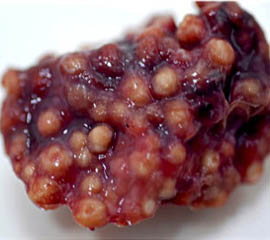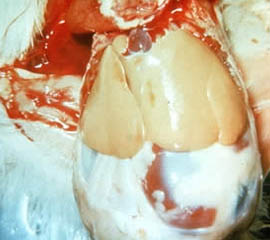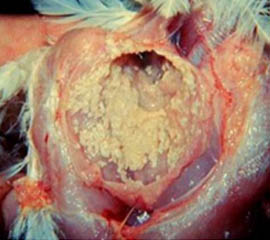 |
|
|
| FUNGAL DISEASES |
| Back |
Aspergillosis (Brooder Pneumonia)
- The condition is caused by Aspergillusfumigatus, a mold or fungus-type organism. Occasionally other types of molds are involved. These organisms are present in the environment of all poultry.
- The bird comes in contact with the organisms through contaminated feed, litter or premises.
- The disease is not contagious and does not spread from one bird to another.
- Most healthy birds can withstand repeated exposure to these organisms.
- Inhalation of large amounts of the infectious form of the mold or reduced resistance of the bird apparently results in infection.
- In the acute form in young birds, main symptoms are gasping, sleepiness, loss of appetite and sometimes convulsions and death. Occasionally the organism invades the brain, causing paralysis or other forms of nervous symptoms.
- The more chronic form in older birds usually results in loss of appetite, gasping or coughing and a rapid loss of body weight. Mortality is usually low and only a few birds are affected at one time.
- The disease produces hard nodular areas in the lungs and an infection of the air sacs. Sometimes the air sac lesions are similar to those produced by infectious sinusitis or CRD. In some birds, colonies of mold growth can be seen on the air sac membranes.
- Diagnosis is usually made from history, symptoms and lesions. It may be necessary to base diagnosis on microscopic lesions.
- The disease can usually be prevented by avoiding moldy litter, feed or premises. There is no treatment for the affected flock. Cleaning and disinfecting the equipment is often helpful.
 |
| Nodular lesions in liver due to Aspergillosis
|
Mycotoxicosis:
- Mycotoxicosis is caused by ingestion of toxic substances produced by molds growing on feed, feed ingredients and possibly litter.
- Several types of fungi produce toxins that may cause problems in poultry, but of primary concern are substances produced by the Aspergillusflavus fungi and are thus called aflatoxins.
- Aspergillusflavus is a common mold that grows on many substances, and grows especially well on grain and nuts. Several other fungi also produce toxins that cause the disease.
- The aflatoxins include four closely related metabolites of A. flavus known as B1, B2, G and G2. The B1 toxin is the most toxic and is of greatest concern to the poultry industry.
- The aflatoxins under certain conditions cause death, reduced growth, reduced egg production, reduced hatchability, signs associated with "physiological stress" and impaired ability to develop immunity to infectious agents. Diagnosis is difficult because characteristic lesions usually are not present, and detection of the toxin is not conclusive.
- Molds are widespread in nature. Standing grains and other feed substances are frequently infected with toxin-producing molds prior to harvest. The key is proper storage to control moisture and temperature to reduce growth of the molds while in storage. Although the mold is present, it cannot produce toxic products unless allowed to grow freely. Aflatoxins in feeds can be detected by chemical tests. Once the toxin is produced there is no known method for removing it from the feed or cancelling its harmful effects. Providing a diet containing high fat and high protein levels and augmenting the ration with vitamin supplements may be of value.
 |
| Mycotoxicosis. |
Moniliasis (Crop Mycosis, Thrush)
- This is a disease that primarily affects the upper digestive tract of all birds and is characterized by whitish thickened areas of the crop and proventriculus, erosions in the gizzard, and inflammation of the vent area.
- It is caused by a yeast-like fungus (Candida albicans).
- Poultry of all ages are susceptible to the effects of this organism.
- Moniliasis is transmitted by ingestion of the causative organism in infected feed, water or environment. Unsanitary and unclean water troughs are an excellent reservoir of the Candida organism. The disease does not however, spread directly from bird to bird. The organism grows especially well on corn, so infection can be introduced by feeding moldy feed.
- This malady produces no specific symptoms. Young birds become listless, pale, show ruffled feathers and appear unthrifty. Some birds exhibit a vent inflammation that resembles a diarrhea induced condition having whitish incrustations of the feathers and skin around the area. Feed consumption may increase by ten to twenty percent.
- Gross lesions are mostly confined to the crop, proventriculus and gizzard. The crop and proventriculus have whitish thickened areas that are often described as having a "turkish towel" appearance. Erosion of the lining of the proventriculus and gizzard is commonly observed, as well as an inflammation of the intestines. Diagnosis is based on history and typical lesions in the flock. Confirmation of the condition is by isolation and laboratory identification of the C. albicans organism.
- Treatment of the flock with an antimycotic drug will control the infection. Many broad spectrum antibiotics will enhance this disease; therefore they should not be used until after control of this condition is completed. Addition of Nystatin (100 g/Ton) or copper sulfate (2-3 lb/Ton) to the feed for seven to ten days should control moniliasis.
 |
| Crop mycosis. |
|
|
| Back |
|
|
Developed by :
|
Dr.Rahulpreet Singh
( M.V.Sc Scholar ) |
Dr. Pranav Kumar
(Assistant Professor)
|
Dr. Amandeep Singh
(M.V.Sc Scholar, IVRI ) |
|
|
|
|
|
|
Scroll
|
| Division of Veterinary and Animal Husbandry Extension Education Faculty of Veterinary Sciences and Animal Husbandry, R.S. Pura, SKUAST Jammu |
|



